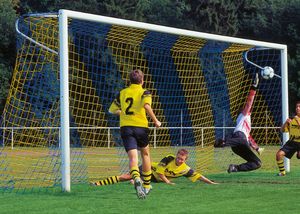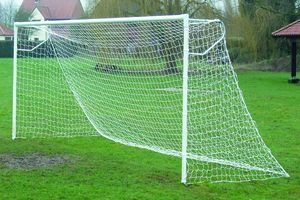What Are The Different Types Of Lines On A Football Pitch? Everything You Need To Know
The lines on a football pitch are an integral part of the game, and understanding their purpose is essential for anyone building a pitch or even just playing or coaching on one.
For someone who has never taken much interest in football before, it might seem a bit confusing having lots of different markings and lines on the pitch. But actually – it's a lot easier to understand than you might think!
Aside from just wanting to know more about how the game works, understanding the different types of lines on a football pitch is also important for anyone planning to construct their own pitch, or for people who want to start playing or coaching the game.
Football pitches come in a few different sizes, and this will depend on the type of football you're playing (for example, an 11-a-side pitch is larger than a 5-a-side pitch), but they all have the same lines. For the sake of consistency, we'll assume that we're looking at a full-sized, 11-a-side pitch.
So what are the different lines on a football pitch you need to know about? Read on to find out more:
Sidelines or Touch Lines
The outermost lines of a football pitch are known as the ‘sidelines’ or ‘touchlines’. They run along either side of the length of the pitch and define the edge of the playing area.
If the football is kicked out of play and over one of the sidelines, then a throw-in is awarded to the team that did not touch it last. It's also where the linesmen (or ‘assistant referees’) stand while they’re officiating the game.
The length of these sidelines can be between 90 and 120 metres (depending on the size of the pitch and the type of football being played).
Goal Line
If the sidelines mark out the length of the pitch, then the goal lines run perpendicular to them and mark out the width. They run from one corner flag to the opposite corner along the pitch’s edge.
The goalposts sit on this line, and when the ball passes over this line and into the goal net, a goal is awarded to the scoring team. However, if the ball exits play past these lines (and not through the goal) then it’s a goal kick to the opposing team that lost the ball out of play.
It also marks out the area in which the goalkeeper is restricted to when a penalty is being taken. If the keeper oversteps this line, then they will be penalised for impeding the penalty taker, and the penalty will be taken again.
The width of the goal lines ranges between 45 and 90 metres.
We Recommend:
Halfway Line
As you might guess, the halfway line sits – well – halfway down the width of the pitch! It separates the two ends of the pitch, splitting the teams into their respective sides.
The home team will typically start on the left-hand side and the away team on the right, and after half-time, they switch sides.
This is also where the kick-off takes place.
Centre Circle
Positioned at the centre of the halfway line is a circle, which is known as the 'centre circle'. The centre circle has a radius of 9.15 metres, and its purpose is to mark out where the kick-off takes place.
In the middle of the circle is the 'centre spot', which is where the football must be placed for the kick-off.
The team that starts the game will be awarded a kick-off by means of a coin toss. The winner of the coin toss gets to decide which team kicks off.
We Recommend:
Penalty Box
The penalty area is one of the most important areas of the football pitch and is where most of the action takes place. It’s located within each of the teams’ defending halves (so either side of the halfway line) and is marked out by a rectangle with lines extending from it
It's approximately 40 metres long and 1 metre wide, extending out from the goal line.
Within these football pitch lines, a player from the opposing team has committed an offence if they:
-
Handle the ball
-
Commits a foul
-
Impedes an opponent
-
Denies an obvious goal-scoring opportunity
If any of these offences take place by the opposing team, then a penalty kick is awarded to the attacking team. However, football rules are constantly changing, and this list isn't exhaustive or definitive, but it's the general rule of thumb.
There is a spot within the penalty area that’s known as the 'penalty mark', which is where the ball must be placed for the penalty kick to be taken from.
Penalty Arc
Attached to the penalty box is a semi-circle known as the penalty arc. If any players not taking the penalty kick enters this area, they're deemed as disrupting play and will be penalised accordingly.
Goal Area - A.K.A the Six Yard Box
The goal area is a small rectangle that extends out from the goal line and within the penalty area, measuring 18 metres wide and 5 metres long.
It's also known as the 'six yard box'.
This is the area in which only the goalkeeper is allowed to touch or play the ball, and any players from either team entering this area without the ball will be penalised for impeding the opposition.
How are Lines on a Football Pitch Marked Out?
Generally, the lines on a football pitch are marked out using white paint that doesn't wear or wash away easily. There are a number of ways in which these lines can be drawn out, but the most common method is to use a pitch marker.
This is simply a machine that can be pulled along the grass by hand and will automatically dispense the paint where the machine leads it to.
Football Line Marking Equipment from Huck Nets
Here at Huck Nets, we supply a variety of equipment for getting your football pitch markings drawn and painted.
Our handy Pitch Line Marker will assist you in creating accurate and professional-looking lines and markings on your pitch, as well as our Ground Marking Indicators, which are really helpful for marking out where your lines should go so you don't lose your place.
Take a look at our whole football ground care range to find everything you need to get your football pitch looking tip-top.
FAQs
How are the lines on a football pitch made?
The lines on a football pitch are created using white paint and a machine called a pitch marker. The pitch marker is pulled along the grass and deposits paint to mark out the lines.
What are the white lines on a football pitch?
The white lines on a football pitch mark out different areas of play, each representing a separate rule. These lines include the sideline (or touchlines), the goal line, the halfway line, the centre circle, the goal box and the penalty area.
Are the lines on a football field painted?
Yes, white paint is used to create the lines on a football field. However, it's not just your regular house paint – it's a special kind of paint that deposits easily onto grass and doesn't wear off easily due to rain or wear and tear.
What do the markings on a football pitch mean?
The different lines on a football pitch are known as the 'markings' and each of them represents a different rule. They consist of the sideline (or touchlines), the goal line, the halfway line, the centre circle, the goal box and the penalty area.


